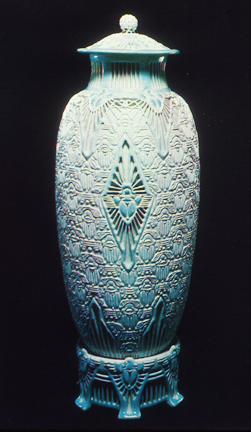Introduction
America has produced several master ceramists, both male and female. Some of the former are John Baymore, Bill Abright, Allen Rosenbaum and Richard Notkin. Listed among the famous female ceramists are Kathy Butterly, Karen Swyler, Lynn Duryea and Adelaide Robineau.
Adelaide Alsop Robineau {1865 – 1929} was born in Middletown, Connecticut (Seco.glendale.edu). Her interest in ceramics began when she took up china-painting which had developed into a hugely well-liked pastime in the wake of the highly successful Centennial Exhibition in Philadelphia in 1876 (Bell). As this only served to whet her appetite for a more advanced ‘hands on’ experience, Adelaide acceded to her ambitions by first learning painting in New York under William Merritt, and then learning the art of ceramics under Charles Binns at the Alfred University in New York (Seco.glendale.edu).
Main body
Adelaide got married to Samuel Robineau in 1899. The couple went on to have 3 children (Bell). Samuel helped his wife establish a little kiln and studio to create her works of art (Seco.glendale.edu). The couple also began Keramic Studio, the first magazine in the U.S on the subject of ceramic arts and potters (Bell). The periodical was greatly instrumental in generating widespread interest in hand-fashioned ceramics, and was also widely credited with introducing the ideas of Art Nouveau of Europe to the U.S. Besides her expertise as a china painter and publisher, Adelaide was also a teacher in two reputed institutions – Syracuse University and The People’s University (Bell).
Swayed by the Arts and Crafts Movement {of which Syracuse in New York was the epicenter} (Seco.glendale.edu) and its significant stress on high standard materials, craftsmanship and avoidance of complex designs, Adelaide experimented extensively in glazes and forms. In a refreshing departure from the usual practice of spreading ornamentation on the unmarked shapes created by other persons, she decided to make her own unique porcelain shapes. Adelaide started creating her own ceramics in 1901. While she is responsible for several masterpieces, the most outstanding is undoubtedly The Scarab Vase (Bell). /var/www/blog-sandbox.itp/wp-content/uploads/2021/09/191621_1.jpg 251×432 24bit N IPTC ICC Adobe JFIF [OK] 125784 –> 121825 bytes (3.15%), optimized.

Adelaide toiled for more than 1,000 hours to create the massive vase mainly in response to the appeal of The People’s University to its staff in 1910 to submit ‘grand public statements in clay.’ (Bell). When the vase was initially taken out of the kiln after its bisque firing, several cracks were found on its surface. Taxile Doat, a ceramist from France who was Adelaide’s adviser at the time, recommended that she use paste to plug in the cracks and then enamel them to equalize the glaze. Adelaide however did things differently.
She plugged in the cracks with a ground porcelain paste and then glazed them with the original glaze she had earlier utilized. When the vase emerged from the kiln the second time, it was found to be in an excellent state, spawning humorous comments that the adviser had actually acquired more information from Adelaide than the other way around (Seco.glendale.edu)
Conclusion
The predominantly repeated design on the vase is the scarab beetle, an insect considered sacred to Egyptians in past civilizations which they believed represented the repeated sequence of day and night, light and death and eternal life. Also called the dung beetle, the scarab beetle shuts the opening of its abode every night by blocking it with a ball of dung {symbolizing the setting of the Sun and onset of darkness} which it pushes aside as it comes out the next day {symbolizing the rising of the Sun and beginning of day}. The Scarab Vase is also called The Apotheosis of the Toiler in a sweeping acknowledgment to all the anonymous craftsmen and craftswomen around the world who put in a lot of toil to come up with their creations just as Adelaide had done to create the Scarab Vase; it is a silent tribute to them all, according them a proper respect that may not be equal to the status of a god, but at least places them on equal status with Adelaide herself (Bell).
References
- “The Apotheosis of the Toiler by Adelaide Robineau.” Glendale Community College. (N/d).
- Bell, Barbara Nicholson. “Adelaide Alsop Robineau, Master Ceramist”. Suite101. 2003. Web.
